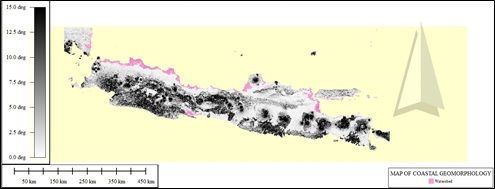The Geomorphological Factors and Its Implications for The Tidal Energy Installations in Java, Indonesia
DOI:
https://doi.org/10.25299/jgeet.2021.6.2.5680Keywords:
Geomorphological factor, tidal energy, IndonesiaAbstract
This study aims to place the tidal energy installation effectively in Indonesia based on geomorphological factors. The survey method was used to analyze the characteristics of beaches in Indonesia. Mathematical physics model was implemented to find the new formulas based on geomorphological factors. Tides are the result of gravitational attraction and the centrifugal effect, which is the drive In the earth-moon system, tidal generating forces are the resultant forces that cause tides, namely: the earth-moon system (FS) centrifugal force and the moon's gravitational force (FB). FS works in the center of the mass of the earth-moon system whose mass point is located on the 3/4 radius of the earth. The style of tidal generator caused by the moon can be calculated by combining Newton's universal gravitational law .The results of this study consist of F = m ac, where the style of the tidal generator caused by the moon can be calculated by combining newton's universal gravitational law in equation and newton's second law of motion in Equation. The another results is tan = , where the formula takes into account constants (K) based on slopes. The last result is the constants (K) for each land form starting on 0,00 untill 1,00. The north coast of Java is more suitable for tidal energy installations because the land form is dominated by alluvium plains of the quaternary age with a lower risk than the southern region of Java. The effectiveness of tidal energy installation depends on the characteristics of the land form. In alluvial plains, the quaternary age of the alluvial plains is more suitable than the hill form volcanic quaternary, tertiary volcanic, and tertiary holokarst.
Downloads
References
Abdjul, T., 2010. Pengaruh Kerapatan Sampel Campuran Sekam Dan Dedak Pada Koefisien Refleksi Dan Koefisien Transmisi Gelombang Kustik. Sainstek 5.
Catto, N., 2020. Atlantic Canada’s Tidal Coastlines: Geomorphology and Multiple Resources, in: World Geomorphological Landscapes. pp. 401–430.
Crotty, S.M., Angelini, C., 2020. Geomorphology and Species Interactions Control Facilitation Cascades in a Salt Marsh Ecosystem. Curr. Biol. 30, 1562–1571.e4.
Deng, G., Zhang, Z., Li, Y., Liu, H., Xu, W., Pan, Y., 2020. Prospective of development of large-scale tidal current turbine array: An example numerical investigation of Zhejiang, China. Appl. Energy 264.
Dronkers, J.J., 1969. Tidal Computations for Rivers, Coastal Areas, and Sea. J. Hydraul. Div. 95, 29–78.
Emery, A.R., Hodgson, D.M., Barlow, N.L.M., Carrivick, J.L., Cotterill, C.J., Mellett, C.L., Booth, A.D., 2019. Topographic and hydrodynamic controls on barrier retreat and preservation: An example from Dogger Bank, North Sea. Mar. Geol. 416.
Finotello, A., D’Alpaos, A., Bogoni, M., Ghinassi, M., Lanzoni, S., 2020. Remotely-sensed planform morphologies reveal fluvial and tidal nature of meandering channels. Sci. Rep. 10.
Heyko, E., 2013. Strategi Pengembangan Energi Terbarukan: Studi Pada Biodiesel, Bioethanol, Biomassa, Dan Biogas Di Indonesia. J. Ilm. Mhs. FEB.
Marrero-Rodríguez, N., García-Romero, L., Sánchez-García, M.J., Hernández-Calvento, L., Pérez-Chacón Espino, E., 2020. An historical ecological assessment of land-use evolution and observed landscape change in an arid aeolian sedimentary system. Sci. Total Environ. 716.
Mejia-Olivares, C.J., Haigh, I.D., Angeloudis, A., Lewis, M.J., Neill, S.P., 2020. Tidal range energy resource assessment of the Gulf of California, Mexico. Renew. Energy 155, 469–483.
Oliveira, M.A., Scotto, M.G., Barbosa, S., Andrade, C.F. de, Freitas, M. da C., 2020. Morphological controls and statistical modelling of boulder transport by extreme storms. Mar. Geol. 426.
Palmer, K., Watson, C., Fischer, A., 2019. Non-linear interactions between sea-level rise, tides, and geomorphic change in the Tamar Estuary, Australia. Estuar. Coast. Shelf Sci. 225.
Pramudji, 2002. Pengelolaan Kawasan Pesisir Dalam Upaya Pengembangan Wisata Bahari. Oseana XXVII, 27–35.
Sangari, F.J., 2012. Rancangan dan Ujicoba Prototipe Pembangkit Listrik Pasang Surut di Sulawesi Utara. J. Ilm. Elit. Elektro 3, 33–36.
Scherelis, C., Penesis, I., Hemer, M.A., Cossu, R., Wright, J.T., Guihen, D., 2020. Investigating biophysical linkages at tidal energy candidate sites; A case study for combining environmental assessment and resource characterisation. Renew. Energy 159, 399–413.
Shaikh Md., T.R., Shaiyek Md., T.B., 2011. Tidal Power : An Effective Method of Generating Power. Int. J. Sci. Eng. Res. 2, 1–5.
Sleiti, A.K., 2015. Overview of tidal power technology. Energy Sources, Part B Econ. Plan. Policy.
Van Coppenolle, R., Temmerman, S., 2019. A global exploration of tidal wetland creation for nature-based flood risk mitigation in coastal cities. Estuar. Coast. Shelf Sci. 226.
Wardhani, I., Purwanto, P., Yosi, M., 2016. Kajian Potensi Arus Laut Sebagai Sumber Energi Alternatif Pembangkit Listrik Di Selat Sugi, Kepulauan Riau. J. Oseanografi 5, 120377.
Wyrtki, K., 1961. Physical oceanography of the Southeast Asian waters. Scietific Resultas Mar. Investig. South China Sea Gulf Thail. 2, 195.
Xu, Y., Cheng, L., Zheng, J., Zhu, Y., Wu, Y., Shi, J., Zhang, W., 2019. Intensive Anthropogenic Influence on the Morphological Evolution of Estuarine Tidal Channels. J. Coast. Res. 35, 1237–1249.
Yi, L., Qian, J., Kobuliev, M., Han, P., Li, J., 2020. Dynamic evaluation of the impact of human interference during rapid urbanisation of coastal zones: A case study of shenzhen. Sustain. 12.

Downloads
Published
Issue
Section
License
Copyright @2019. This is an open-access article distributed under the terms of the Creative Commons Attribution-ShareAlike 4.0 International License which permits unrestricted use, distribution, and reproduction in any medium. Copyrights of all materials published in JGEET are freely available without charge to users or / institution. Users are allowed to read, download, copy, distribute, search, or link to full-text articles in this journal without asking by giving appropriate credit, provide a link to the license, and indicate if changes were made. All of the remix, transform, or build upon the material must distribute the contributions under the same license as the original.










